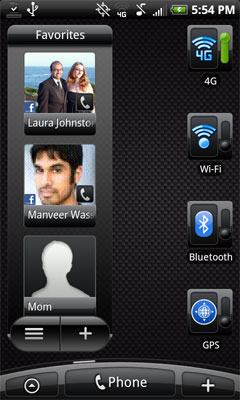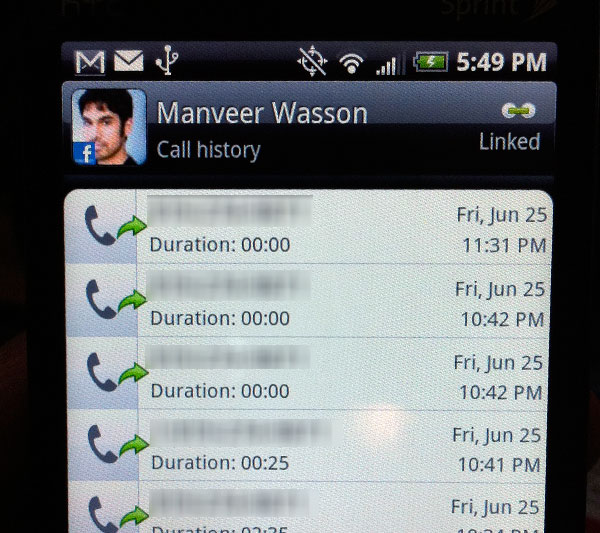The Sprint HTC EVO 4G Review
by Anand Lal Shimpi on June 28, 2010 6:04 PM ESTThe Basics
The EVO 4G currently ships with Android 2.1, although sometime before the end of the year it should get 2.2. Layered on top of Android is a set of HTC developed apps, widgets and UI modifications called Sense. As a whole HTC’s Sense makes Android a much more polished experience and is generally a positive thing. The downside is that it takes HTC longer to bring Android updates to its phones as it has to not only port the updated Android code but also make sure that Sense works with it as well. I’ve already looked at Sense in my Incredible review and talked about Android in my Nexus One review. What follows here is a brief refresher as well as an update on some things I didn’t touch last time around.
The lock screen is different but no better or worse than what I’ve seen on other Android phones like the Nexus One. Instead of swiping left to unlock, you swipe down. If your phone is locked and you get a call you just swipe down to answer and swipe up to decline.
When locked any incoming text messages appear with a preview at the bottom of the screen. This is in addition to the usual notifications up top which I’m happy to say I’ve finally gotten used to and definitely appreciate above and beyond what Apple does in iOS. I still have a fondness for webOS’ notification system but until we see a resurgence of Palm under HP management I’ll have to count them out of the smartphone wars.
The main home screen has a calendar/weather widget and icons for Messages, People (Contacts), Mail, the Android Market, the Camera and Voicemail. You can add your own icons by hitting the menu button and selecting the Add to Home option.

There are a total of 7 home screens that you can configure on the phone. Three to the left and three to the right of the main screen I just described. The default EVO 4G skin has a page with an MP3 player widget as well as a bunch of Sprint apps, a page with a Bookmarks widget for frequently accessed websites and one more with a Friend Stream widget that combines your Facebook and Twitter updates into a single stream of other peoples’ lives. The other three home screens include a calendar, Google search bar and widgets to turn off things like 4G, WiFi, Bluetooth and GPS.

The quick access to turning off 4G and WiFi is pretty nice, although in practice the 4G toggle didn’t get as much use as I thought it would.
The favorites widget automatically populates itself with frequently dialed contacts. If you supply your Facebook login information it will also indicate if your contact has updated their Facebook page. Unfortunately trying to view a Facebook profile from a contact’s info page won’t launch Facebook’s Android app but instead just load the mobile version of Facebook in the browser.
Cloud Integration
Like all other Android devices, the EVO 4G integrates with the cloud very well assuming you actively use a couple of key services: Google apps and Facebook. If you supply your login information to those services (you can also add Flickr and Twitter) pretty much every aspect of your phone will automatically integrate itself into your life before you can even think of the word sync.
Contacts will automatically get pulled from your Google contacts and Facebook friends list. Email addresses, phone numbers, addresses, photos, everything all get integrated onto your phone. If anyone changes their contact information in Facebook it’ll get updated on your phone. If you update a contact in Google the same will happen on your phone. It’s very nice. If you don’t use those services then the EVO works more like a regular phone but without good supplied desktop sync software.
The cloud integration is ridiculously convenient. It’s useful enough that it makes going to most other devices feel ancient. Even if you don’t have your life in the cloud, stepping foot into the Android world is generally enough to make you want to change.
Organization by Person
Once you’re all synced up with the cloud Android truly behaves like a Google product: it just works on organizing data. Here are all of the things you can do when you’re looking at a single contact on the EVO 4G (or any other HTC Sense enabled device):
- View Contact Information including available personal information from Facebook
- View all SMSes exchanged with the contact
- View all emails exchanged with the contact
- View latest Facebook and Flickr updates and albums
- View a log of all calls between you and the contact (you can also clear the call log history)
The functionality itself is above and beyond anything Apple offers, but it gets better. There’s full customization available on anything I mentioned above.
Want to see only the past day worth of Facebook updates for the contact? That’s configurable. Want to see the past 30 days of Facebook updates? You can set that as well, all on a contact by contact basis.

You can also do typical cellphone stuff to each contact. You can opt to send the contact straight to voicemail whenever they call or choose specific ringtones. Linking a contact to their Facebook profile is particularly helpful since we’re vain creatures and tend to share our birthdate with our FB friends. You now have a quick way of figuring out when someone’s birthday is just by pulling up the contacts in your phone.
If this all sounds like stuff you’d never want to deal with, you don’t have to. The EVO 4G still works like a normal smartphone. The flexibility is simply a selling point of Android.










97 Comments
View All Comments
Strk - Monday, June 28, 2010 - link
Last I knew, it was free roaming regardless. The minutes is just anytime, which for Sprint is 7am to 7pm (free nights and weekends). But like you said, you get unlimited mobile to mobile regardless of the other person's carrier.I wonder how this thing will stack up against the Samsung Galaxy S phones? I believe all the major carriers are getting one.
ed1112ward - Monday, June 28, 2010 - link
Yup, as a owner of the phone i can confirm then $10 evo tax, err I mean "Premium Data" charge.ChillyPenguin - Monday, June 28, 2010 - link
The 69.99 plan only include 450 minutes to land lines, while it does include unlimited minutes to any cellphone on any network. This review is correct in listing the 900 minute plan as 99.99 including the $10/mo 4G fee. That being said, my wife and I are on a sprint "Simply Everything" 1500 minute shared plan. By the time we get free calling to all cell phones and free nights and weekends, we used less than 300 minutes combined last month.Alexstarfire - Monday, June 28, 2010 - link
It's hard to really compare AT&T prices to Sprint prices since you can't get the exact same plans most of the time. Sprint truly has an "unlimited everything" option while AT&T has a 2GB max limit now. The fact that AT&T ended up being cheaper once tethering is included means little if you go over every month. With 4G and a true unlimited plan it's a pretty safe bet to say that Sprint has a much better plan in place. You can actually use it like it's supposed to be used.I'm very disappointed to hear about the screen in the EVO. A TFT, really? Why sully a great device with a craptastic screen? Not that the screen can't look good, but it'll never look as good as an AMOLED.
And I agree with another person on here that this topic needs to be revisited with Froyo on the device. Would also be worth noting if there is a difference between stock and a "formatted" phone so-to-speak. It would suck to see a stock phone behaving like most stock laptops, but it's still something I'd like to know.
solipsism - Monday, June 28, 2010 - link
In some areas, sure. Like display size, aspect ratio and the built in kickstand. But I would argue the EVO 4G loses that title by having a worse panel type and dot pitch over the new iPhone 4; and, most importantly, such a short playback time whist in Airplane Mode.PS: To extend your entertainment needs one can continuously charge their smartphone from their laptop if on a long flight without access to power. You should be able to get at least 4 charges out of the average notebook.
DigitalFreak - Monday, June 28, 2010 - link
I'm waiting to see how the Droid X pans out. Unfortunately, Verizon is quite a bit more expensive than Sprint, and they don't have any "4G" options. Never been a fan of HTC either.Zebo - Tuesday, June 29, 2010 - link
Great review Anand. Good things come to those who wait, right.:PEvo is a non starter for me since I spend at hours on the phone each day and in the field and battery life kills it in addition to poor screen outside.
Looking forward to iPhone review on battery life and outdoor capability.:)
fifoloveritas - Monday, June 28, 2010 - link
The 30 charge is for wireless hotspot, which is not available on iPhone. Not sure if it's available on any other phone. There's no charge for regular tethering, phone has Share Connection option when it is plugged into USB.Mr Perfect - Monday, June 28, 2010 - link
Anand,I've noticed that the majority of articles on the site lately have been for phones, consoles, laptops and other pre-assembled consumer electronics. Is this the new focus of AT? Has there simply been a dry spell of PC components?
Thanks,
MP
Anand Lal Shimpi - Monday, June 28, 2010 - link
I've got a stack of SSDs here that need work and we'll have new GPUs coming very soon. The smartphones are hot right now but we'll see things come and go in waves. If there's a demand for us to review it, we will :)Take care,
Anand